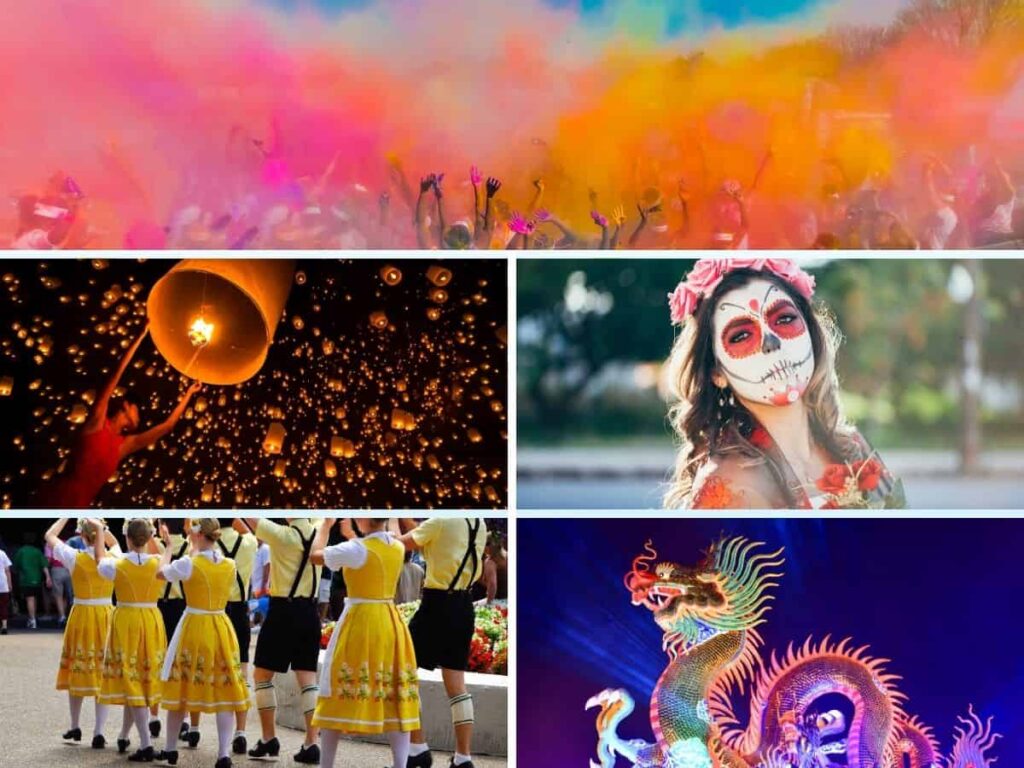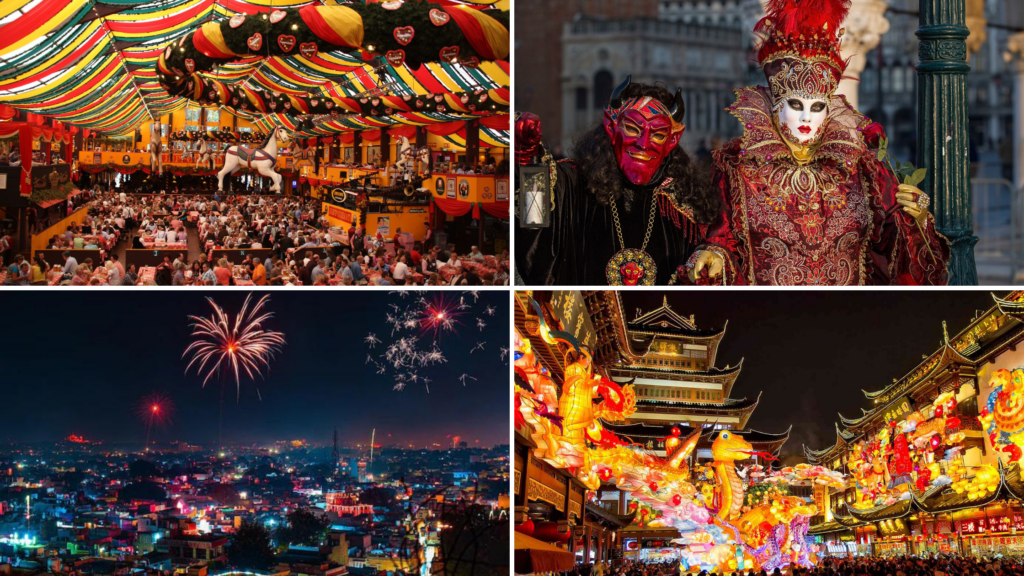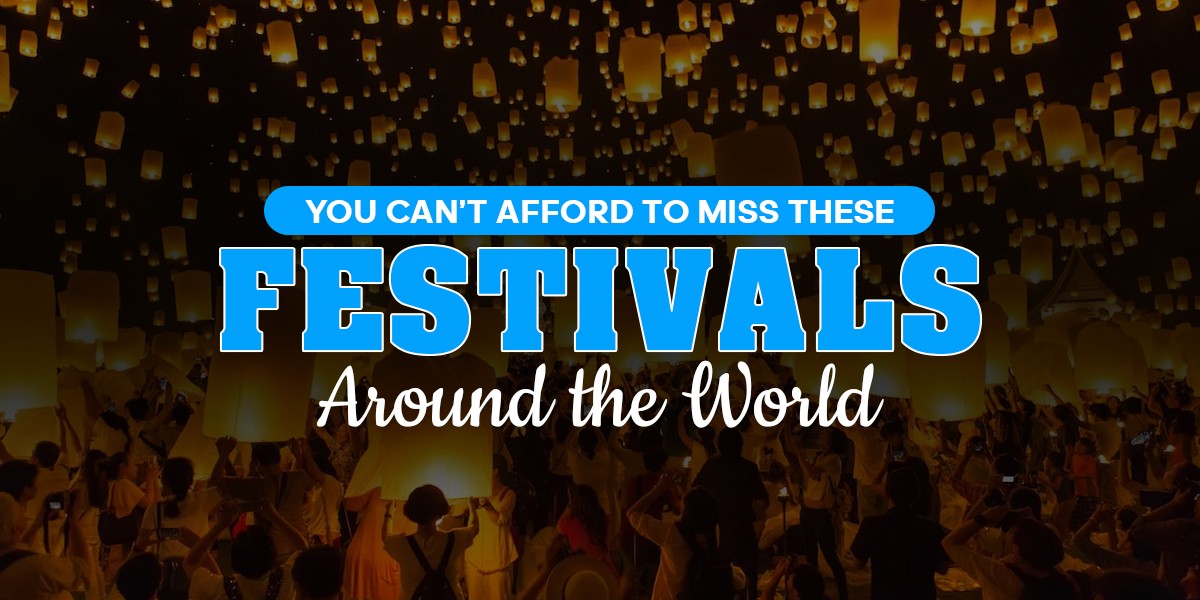Cultural Festivals Around the World
Cultural festivals are lively, all-encompassing events that provide a profound understanding of the customs, principles, and creative manifestations of various cultures. They unite people to celebrate common human experiences by bridging linguistic, cultural, and geographic divides. These celebrations offer a special insight into the spirit of a community through their music, dance, food, and religious ceremonies. This post will discuss some of the world’s most fascinating cultural festivals that you should not miss.

1. Carnival – Rio de Janeiro, Brazil
Rio de Janeiro’s Carnival is a spectacular exhibition of color, music, and dance, and it’s arguably the most well-known carnival in the world. This event, which takes place every year before Lent, is a profoundly ingrained celebration of joy and life in Brazilian culture. Rio comes to life with samba music, colorful costumes, and extravagant parades that include thousands of dancers and enormous floats.
The Samba Parade, which features samba schools competing in a lavish presentation that highlights their beautiful costumes, sophisticated dance routines, and themed floats, is the highlight of Carnival. After the parades, every area in the city transforms into a block party, known as a “bloco.” Rio is turned into a throbbing, rhythmic celebration of Brazilian culture and the spirit of community for five days.

2. Diwali – India
One of the most significant and extensively observed holidays in India is Diwali, commonly referred to as the Festival of Lights. It represents the triumph of good over evil and light over darkness. All throughout the nation, Diwali is celebrated with great fervor, and each region adds its own distinctive traditions and rituals.
The primary day of Diwali is celebrated by burning oil lamps (diyas) and candles in homes, temples, and public areas. The festival usually lasts for five days. Families gather to exchange gifts, share candies, and enjoy joyful meals as fireworks light up the night sky. With customs celebrating the goddess of wealth and prosperity, Lakshmi, Diwali is also a time for introspection and prayer. The festival is a must-attend event because of its unique blend of colorful celebrations, profound spiritual importance, and the coziness of family get-togethers.
3. La Tomatina – Buñol, Spain
A unique and lively celebration, La Tomatina takes place every year in the Spanish village of Buñol. Thousands of people travel from all over the world to this tomato-throwing celebration, eager to join in on the joyful pandemonium and mess.
Although the festival’s beginnings are not entirely established, it has been observed since the middle of the 20th century and has become more and more well-known over time. Every last Wednesday in August, the participants assemble in the town square of Buñol, where an enormous food fight involving overripe tomatoes ensues for around sixty minutes. By the time the event is completed, participants are completely covered in crimson, and the streets are littered with tomato pulp. La Tomatina is a well-run festival with regulations in place to guarantee everyone’s enjoyment and safety, despite the lighthearted mayhem.
4. Holi – India and Nepal
One of the happiest and most extensively observed holidays in India and Nepal is Holi, also known as the Festival of Colors. It heralds the coming of spring and the triumph of right over wrong. People celebrate the occasion with great fervor, dancing, singing, and hurling colored powder, or gulal, at one another in the streets.
The night before the main festival, Holi ceremonies start with a bonfire, which represents the victory of good over evil and the burning of the demoness Holika. People congregate in public areas the next day to celebrate with dancing, music, and colorful color tossing. People of all ages, origins, and socioeconomic classes gather to celebrate Holi, a time for forgiveness, rebirth, and the dismantling of social barriers. The festival of Holi is unlike any other because of its brilliant colors, contagious enthusiasm, and inclusive spirit.
5. Oktoberfest – Munich, Germany
Munich, Germany hosts Oktoberfest, the largest beer festival in the world, every year. With authentic music, filling food, and plenty of beer, it’s a celebration of Bavarian culture. The event was first conducted to mark Crown Prince Ludwig’s marriage to Princess Therese of Saxe-Hildburghausen in the early 1800s.
Millions of people travel from all over the world to attend Oktoberfest these days, drawn by the vibrant atmosphere, the traditional attire (dirndls and lederhosen), and the world-famous Bavarian beer served in enormous steins. Theresienwiese, the festival grounds, are lined with beer tents, carnival attractions, and food vendors selling Bavarian fare like roast chicken, sausages, and pretzels. Oktoberfest is a must-see cultural event because it’s more than simply beer—it’s a celebration of Bavarian heritage and hospitality.
6. Day of the Dead (Día de los Muertos) – Mexico
Celebrated across Mexico, Día de los Muertos, also known as the Day of the Dead, is a unique and profoundly poignant holiday. The Day of the Dead is a joyful celebration of life and commemoration of loved ones who have passed away, unlike Halloween, to which it is frequently compared.
The event is held on November 1st and 2nd, which are All Saints’ Day and All Souls’ Day in the Catholic calendar. In their homes and at graves, families erect or build ornate altars (ofrendas) that are adorned with pictures, candles, marigold flowers, and food and drink offerings for the deceased. Traditional dishes such as pan de muerto (bread of the dead) and sugar skulls are made and distributed. Families gather to celebrate the memories of their ancestors in an atmosphere of love, memory, and celebration.
The Day of the Dead is celebrated in Mexico City with parades, open-air ofrendas, and cultural activities that showcase the city’s diverse customs and beliefs about dying and the afterlife. The festival is one of the most remarkable cultural events in the world because of its distinctive fusion of pre-Hispanic and Christian components and its lively, joyous mood.
7. Chinese New Year – China and Across the Globe
Chinese populations worldwide celebrate Chinese New Year, commonly referred to as the Spring Festival, which is the most significant traditional holiday in China. The holiday, which heralds the start of the lunar new year, is a time for gatherings with family, food, and cultural events.
The “Reunion Dinner,” or New Year’s Eve dinner, is the most significant meal of the year for Chinese families, and the festivities usually run for 15 days. Giving red envelopes (hongbao) stuffed with cash, shooting off fireworks to chase away bad spirits, and doing lion and dragon dances to bring good fortune are some of the practices that hold significance.
The Chinese zodiac assigns a year to one of the twelve animals, and the celebration is replete with traditions and symbolism meant to usher in wealth, well-being, and joy. Chinese New Year is a truly international festival because of the bright parades, eye-catching decorations, and joyous ambiance.
8. Venice Carnival – Venice, Italy
One of the most recognizable and sophisticated cultural events on the planet, the Venice Carnival is well-known for its complex masks, lavish costumes, and lavish balls. The carnival was first held in the 12th century as a way for Venetians to celebrate without being constrained by Lent.
The donning of masks, which enables participants to conceal their identities and socioeconomic situations and fosters an air of mystery and intrigue, is the centerpiece of the Venice Carnival. Venice’s waterways and ancient buildings provide a breathtaking backdrop for the city’s masked parties, parades, and street acts.
A well-known carnival event is the “Flight of the Angel,” which commences the celebrations with a costumed actor falling from St. Mark’s Square’s Campanile tower. Anybody who values beauty and tradition should attend the Venice Carnival, which is a celebration of art, culture, and history.
9. Mardi Gras – New Orleans, USA
Mardi Gras, also known as “Fat Tuesday,” is a vibrant and exuberant celebration held in New Orleans, Louisiana. Although the festival’s origins are rooted in medieval and ancient Roman customs, it has developed into a distinctively American festival of food, music, and fun.
The Feast of the Epiphany, January 6, marks the start of Mardi Gras, which ends on Fat Tuesday, the day before Ash Wednesday. The celebration is renowned for its extravagant parades, which include marching bands, floats, and riders wearing masks who toss beads, doubloons, and other gifts to the assembled spectators. People in bright costumes, music, and dancing fill the streets of New Orleans as everyone takes in the joyous occasion.
Apart from the parades, another highlight of Mardi Gras is its cuisine, especially King Cake, a sugary confection that is typically consumed during the celebration. One of the most fascinating and distinctive events in the country, Mardi Gras honors life, music, and New Orleans’ rich cultural legacy.
10. Edinburgh Festival Fringe – Edinburgh, Scotland
Every year, the Scottish capital hosts the largest arts event in the world, the Edinburgh event Fringe. As an alternative to the Edinburgh International Festival, the Fringe was founded in 1947 and has since expanded to become a global festival honoring artistic expression and innovation.
Thousands of performances in a variety of genres, including as spoken word, dance, comedy, theater, and music, are showcased during the festival. International artists go to Edinburgh to present their work, and events are held in a variety of settings, from opulent theaters to cozy bar backrooms.
Because of its open-access approach, which allows anybody with a production to join, the Fringe is renowned for providing a platform for both established artists and up-and-coming talent. The festival is a must-visit for both art fans and cultural vultures due to its lively atmosphere, wide range of acts, and celebration of creativity.
Conclusion
Cultural festivals present a singular chance to immerse oneself in the depth and variety of human expression. The vivid hues of Holi, the upbeat beats of Rio’s Carnival, or the exquisite masks of Venice—all of these celebrations highlight the richness of local customs and unite people in mutual happiness and festivity. We connect with the common principles of community, creativity, and joy by attending these festivals and learning more about other cultures. So gather your belongings, welcome the spirit of exploration, and make sure you don’t miss these amazing global cultural festivals!










Leave a Reply